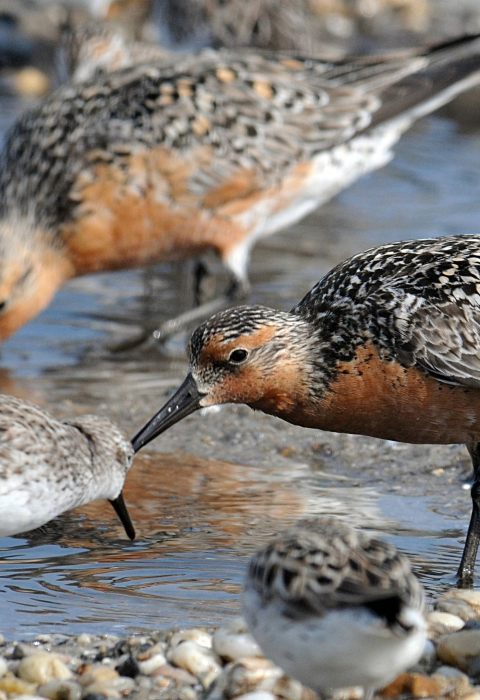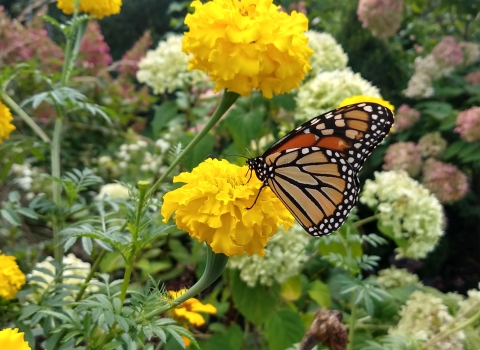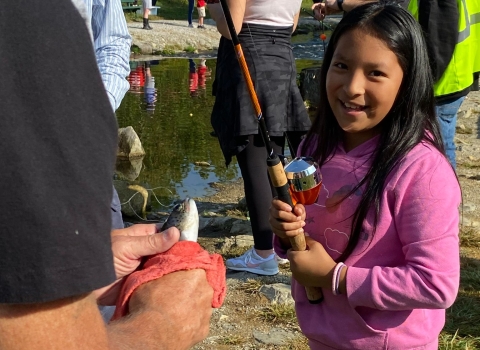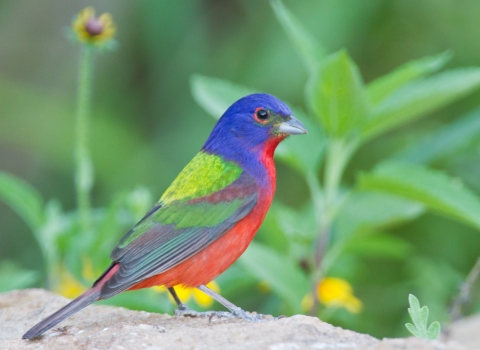- Why is the U.S. Fish and Wildlife Service proposing to designate critical habitat for the rufa red knot?
- Why did the Service revise the critical habitat proposal published July 15, 2021?
- In the revised proposal, what areas would be designated as critical habitat?
- Is the U.S. Fish and Wildlife Service already reviewing activities that may affect the rufa red knot?
- What would critical habitat add to consultations that have already been required by a red knot’s status as threatened?
- Does a critical habitat designation affect all activities that occur within the designated area?
- How did the Service determine what areas to include as proposed critical habitat?
- What value would critical habitat provide the rufa red knot?
- What would change if critical habitat is finalized?
- What kinds of modifications is the Service already requesting through consultation on rufa red knot?
- What would critical habitat designation mean for a beach landowner?
- What would critical habitat mean for recreational use?
- What would critical habitat mean for shoreline stabilization or beach replenishment projects?
- Why do some unit boundaries appear to be in water?
1. Why is the U.S. Fish and Wildlife Service proposing to designate critical habitat for the rufa red knot?
The rufa red knot was listed as threatened under the Endangered Species Act (ESA) on January 12, 2015. According to the ESA, critical habitat can be designated, if prudent and determinable, for any species determined to be endangered or threatened. The proposed critical habitat for the rufa red knot would encourage partners to incorporate conservation measures that benefit this species into habitat management.
Federal agencies that undertake, fund, or permit activities that may affect critical habitat must consult with the Service to ensure their actions do not adversely modify or destroy designated critical habitat. However, the agency has determined that the designation, if finalized, would not require federal agencies to change their current approach to reviewing federal actions, such as those involving recreation, development, or other activities in rufa red knot habitat.
2. Why did the Service revise the critical habitat proposal published July 15, 2021?
During the comment period for the proposal published July 15, 2021, the Service received new information—mainly additional data sets of rufa red knot observations —that prompted a reevaluation of the best available information in some areas. This revision includes a total of seven new units located in Georgia, Massachusetts, New York, North Carolina, South Carolina, and Virginia; revised units in Georgia, Massachusetts, New Jersey, South Carolina, and Texas; and corrections to the reported size of four other units and to the total acreage.
The critical habitat units identified in Alabama, Delaware, Florida, Louisiana, and Mississippi in the proposed rule published in July 2021 have not changed.
The revised proposed rule does not add units in states or counties that weren't included in the original proposal.
3. In the revised proposal, what areas would be designated as critical habitat?
The revised rule proposes to designate 683,405 acres of critical habitat across 13 states for the rufa red knot. This revision amounts to an overall increase of 32,615 acres from the proposal published July 15, 2021, due to added areas, revisions to previously proposed units, and acreage corrections.
The proposed designation focuses conservation efforts in coastal areas that have the most rufa red knot activity and reinforces the Service's recommendations for project modifications. Although the species is known to migrate over land, no inland stopovers are included in the critical habitat proposal. All proposed units are occupied migration and wintering areas for the species.
The proposal includes areas of Alabama, Delaware, Florida, Georgia, Louisiana, Massachusetts, Mississippi, New Jersey, New York, North Carolina, South Carolina, Texas, and Virginia.
The ranges of a total of 17 other threatened and endangered species overlap with the proposed critical habitat for the rufa red knot, and many of the proposed critical habitat units overlap in part or whole with existing critical habitat designated for some of those 17 species. Specifically, about 40 percent of the proposed critical habitat area — amounting to 261,087 acres — coincides with existing critical habitat for piping plover, West Indian manatee, Gulf sturgeon, and aboriginal prickly apple.
Existing critical habitat can be explored through an online map.
4. Is the U.S. Fish and Wildlife Service already reviewing activities that may affect the rufa red knot?
Yes, the ESA provides protections for threatened or endangered species, regardless of critical habitat designation. Activities with a federal nexus, such as federal funding, permitting or licensing, that may affect listed species are subject to consultation under section 7 of the ESA to consider whether they may jeopardize the existence of the species. Since 2015, the Service has consulted on rufa red knot conservation in more than 1,400 activities and projects, primarily shoreline stabilization, habitat restoration and coastal development. The Service anticipates continuing to recommend similar project modifications even if the proposed critical habitat is finalized.
5. What would critical habitat add to consultations that have already been required by the red knot’s status as threatened?
As a listed species under the ESA, rufa red knots are already protected wherever they occur, and federal agencies are required to consult on any action they conduct, fund and/or permit that might affect the species. The ESA requires the Service to identify the location of habitat essential to the conservation of the species, which is considered "critical habitat."
If critical habitat is designated, the responsibility of federal agencies to consult on the rufa red knot broadens. Critical habitat triggers an additional analysis evaluating whether an action will diminish the recovery potential or conservation value of the designated area. Federal agencies must consider the potential for activities to result in the destruction or adverse modification of critical habitat.
Any time and effort spent on this additional analysis, as well as the costs and benefits of implementing any recommendations resulting from this review, are economic impacts of the critical habitat designation. Since the Service anticipates continuing to use typical conservation measures already recommended through consultation, the designation would require additional time primarily to document the critical habitat.
6. Does a critical habitat designation affect all activities that occur within the designated area?
No. Only activities that involve a federal permit, license, or funding and that may impact the area of critical habitat will be affected. If this is the case, the Service will work with the federal agency and, where appropriate, private or other landowners to adjust their project so it can proceed without adversely modifying the critical habitat. Thus, most federal projects are likely to go forward as planned, but some could be modified to minimize harm to critical habitat. In the case of the rufa red knot, the Service anticipates recommending similar conservation measures regardless of whether critical habitat is designated.
7. How did the Service determine what areas to include as proposed critical habitat?
Critical habitat is defined as the specific areas within the geographical area occupied by the species at the time it is listed, in accordance with the ESA, on which are found physical or biological features essential to the conservation of the species and that may require special management considerations or protection. It can also include areas outside the geographical area occupied by the species, but the Service did not recommend this for the rufa red knot.
The Service applied information about the rufa red knot’s needs to identify the following physical and biological features:
(1) Beaches and tidal flats used for foraging.
(2) Upper beach areas used for roosting, preening, resting or sheltering.
(3) Ephemeral and/or dynamic coastal features used for foraging or roosting.
(4) Ocean vegetation deposits or surf-cast wrack used for foraging or roosting. Wrack is natural material like seaweed, algae, and invertebrates, that washes up on the beach.
(5) Intertidal peat banks used for foraging and roosting.
(6) Features landward of the beach that support foraging or roosting.
(7) Artificial habitat mimicking natural conditions or maintaining any of the features mentioned above.
A detailed step-down methodology was developed for identifying proposed critical habitat units. The methodology ensured consistent rufa red knot use and considered migration patterns, landforms, and breaks in suitable habitats and food availability among other elements.
The proposal is underpinned by a 2020 scientific species status assessment that underwent expert, partner, and peer review, including input from at least 40 agencies and organizations. Sources of data include 2020 eBird data and many local and regional sources, such as reports, databases, and geolocator/resighting data maintained by state wildlife agencies, universities, local governments and nonprofit organizations across the range of the species.
8. What value would critical habitat provide the rufa red knot?
Rufa red knot numbers dropped significantly in recent decades, a result of multiple threats that have impacted habitat and food supply across its range. The Service, state natural resource agencies and nonprofit organizations are using the best available science to work together for the rufa red knot’s recovery. The critical habitat proposal reinforces the importance of habitat for recovery. Maintaining natural stretches of beach and other coastal habitats is extremely important for shorebirds and other wildlife that depend upon them. Intact coastal systems are also more resilient to climate change climate change
Climate change includes both global warming driven by human-induced emissions of greenhouse gases and the resulting large-scale shifts in weather patterns. Though there have been previous periods of climatic change, since the mid-20th century humans have had an unprecedented impact on Earth's climate system and caused change on a global scale.
Learn more about climate change , which benefits communities.
9. What would change if critical habitat is finalized?
If the proposed critical habitat is finalized, the Service does not anticipate needing to expand its current approach to conservation measures as part of consultation under section 7 of the ESA. The agency will continue to work with federal, state, Tribal and local partners to conserve the species throughout its range.
10. What kinds of modifications is the Service already requesting through consultation on rufa red knot?
Since the species was listed in 2015, the Service has consulted on more than 1,400 activities and projects, primarily shoreline stabilization, habitat restoration and coastal development. The Service anticipates that typical conservation measures already being recommended during consultations would remain the same. These include:
Avoiding new coastal developments in and near important rufa red knot habitats.
Avoiding hard or intensive shoreline stabilization in sparsely developed areas.
Evaluating development setbacks to allow for habitat migration.
Planning beach nourishments to minimize adverse effects to rufa red knots, their prey, and their habitats.
Planning dredging to minimize adverse effects to rufa red knots, their prey, and their habitats.
Avoiding or minimizing vegetation planting in rufa red knot habitats.
Minimizing and monitoring disturbance of rufa red knots during construction or project activities.
Minimizing and monitoring disturbance of rufa red knots from other human activities.
Minimizing and monitoring disturbance of rufa red knots from predators.
Avoiding activities likely to impact horseshoe crabs.
Avoiding deliberate introductions of nonnative marine species.
Situating both terrestrial and offshore wind turbines away from important rufa red knot habitats and flight paths.
Including rufa red knots and their habitats in response plans.
Avoiding and/or minimizing disturbance of natural wrack.
Avoiding or minimizing beach raking in rufa red knot habitats when the birds are typically present.
11. What would critical habitat designation mean for a beach landowner?
The Service is committed to working with beach communities and landowners to use ESA tools and flexibilities to support coastal management while conserving the rufa red knot. The designation would not affect land ownership, set aside lands or establish a wildlife refuge. Only activities that involve a federal permit, license, or funding may be affected. If needed, the Service will work with the federal agency and landowner to adjust their project so that it can proceed without adversely modifying the critical habitat. Most federal projects are likely to go forward as planned, but some could be modified to avoid or minimize harm to critical habitat.
In the case of the rufa red knot, federal agencies have been routinely consulting on the bird due to its listing under the ESA, and the Service anticipates continuing to recommend similar conservation measures regardless of whether critical habitat is designated.
12. What would critical habitat mean for recreational use?
Since the rufa red knot has been federally protected since 2015, many management actions are already in place to minimize disturbance from recreation. The Service anticipates continuing to provide similar recommendations for recreational activities that involve a federal permit, license, or funding, regardless of whether critical habitat is designated.
While migrating and wintering in the U.S., rufa red knots look for safe, undisturbed areas along bays, inlets, and the ocean they can use for resting and feeding. The Service encourages beachgoers to walk around (not through) flocks of birds, and if pets are allowed, to keep them on leash and away from the birds. Leaving natural material (called wrack) that washes up on the beach and preserving intertidal areas helps provide abundant food sources for the species.
13. What would critical habitat mean for shoreline stabilization or beach replenishment projects?
The Service anticipates continuing to recommend similar project modifications, even if the proposed critical habitat is finalized. Maintaining natural stretches of beach and other coastal habitats is extremely important for shorebirds and other wildlife that depend upon them. Intact coastal systems are also more resilient to climate change, which benefits communities. The Service is committed to working with agencies, communities, and beach landowners to use ESA tools and flexibilities to support coastal resiliency.
14. Why do some unit boundaries appear to be in water?
Most of the units contain highly dynamic barrier beaches and intertidal seashore areas that are covered at high tide and uncovered at low tide. This area has the potential to vary year to year. The precise location of the physical or biological features may shift daily as a result of tides but also may shift over time because of the intrinsically dynamic nature of shorelines and barrier islands and rising sea levels.
The physical or biological features the Service describes are in the intertidal areas and sandy beaches up to the vegetated areas that do not contain the physical or biological features, noting that availability of different habitats based on the tide cycle may also cause rufa red knots to vary foraging or roosting locations throughout a day or forage at night.



